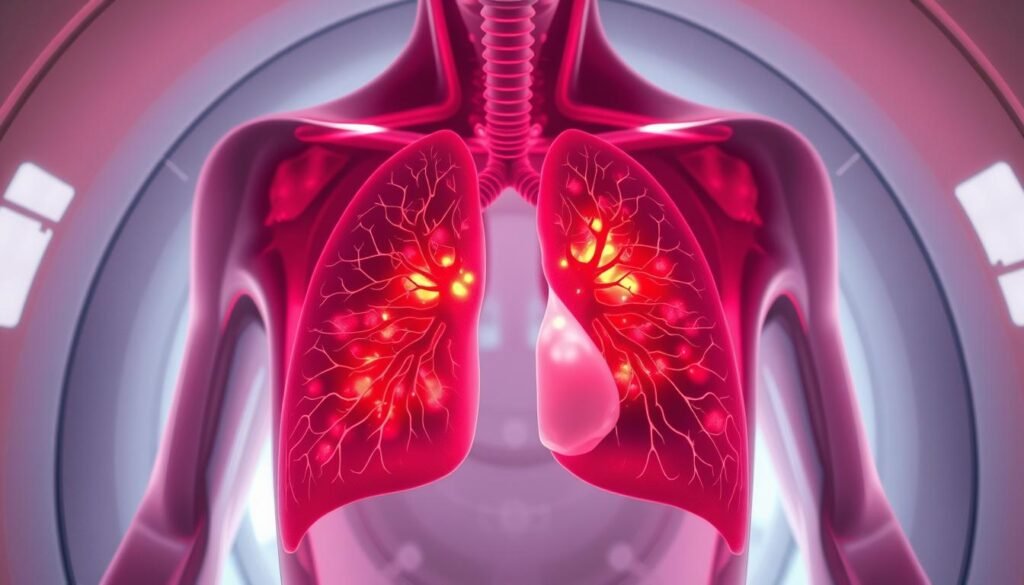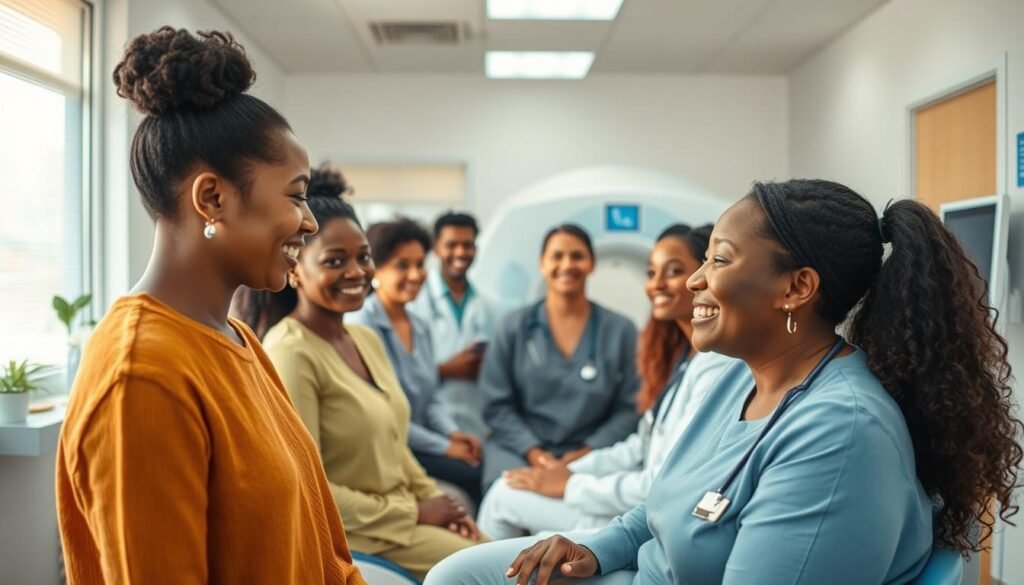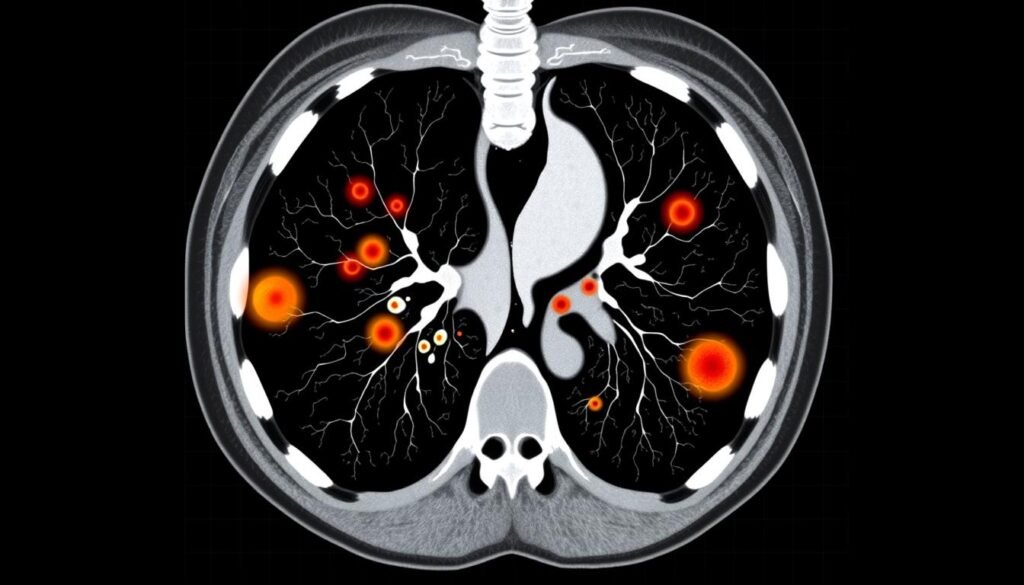About 20% of all cancer deaths in the US are caused by lung cancer. The early spotting of lung cancer can greatly better treatment results and chances of survival. This highlights why CT scan lung cancer detection is key. Low-dose CT scans allow doctors to find potential lung tumors much earlier than old chest X-rays do. This helps people at high risk to take steps to care for their health sooner.
This early detection guide for lung cancer helps you understand how CT scans work in spotting lung cancer. It covers the current screening methods and the important rules on who should be screened. You’ll learn the differences between screening choices and how vital it is for patients and doctors to make those decisions together. It also points you to more resources for help. For extra info on lung cancer screening, visit Lung Cancer Basics.
Key Takeaways
- Early detection of lung cancer is critical for successful treatment and improved survival rates.
- Low-dose CT scans are more effective than chest X-rays in identifying lung tumors.
- Guidelines recommend regular screening for high-risk individuals, including longtime smokers.
- Patient involvement in decision-making about screening options is essential for optimal health outcomes.
- Understanding the risks and benefits of lung cancer screening can aid in making informed health choices.
Understanding Lung Cancer: Facts and Statistics
Lung cancer is a major health issue in the United States. It ranks as the second leading cancer and the top cause of cancer deaths. Knowing the facts about lung cancer helps raise awareness and drive action.
Prevalence of Lung Cancer in the United States
About 1 in 15 men and 1 in 17 women will get lung cancer in their life. Everyone needs to know about lung cancer risk factors, especially those most at risk. The biggest causes include smoking, the environment, and family history.
Risk Factors and Common Symptoms
Many things can raise your chances of getting lung cancer. Top lung cancer risk factors cover:
- Smoking, for both current and past smokers.
- Being around secondhand smoke.
- Touching dangerous substances like asbestos.
- Having lung cancer in your family history.
Finding common lung cancer symptoms early can help catch it sooner. Symptoms often appear late, making it hard to find early. Look out for these signs:
- A cough that won’t go away.
- Chest pain that gets worse when you breathe or cough.
- Losing weight without trying.
- Coughing up blood.
- Having trouble breathing or wheezing.
Visit this link for details on early warning signs. Paying attention to these signs is key to early diagnosis and treatment.
The Role of Early Detection in Lung Cancer Treatment
Finding lung cancer early is key to improving survival rates. Catching it in early stages greatly improves treatment outcomes. Patients with early-stage lung cancer often have a better future. They can undergo more effective surgeries.
Why Early Detection Can Save Lives
Spotting lung cancer early can truly save lives. Screening with low-dose CT scans helps catch it at stage I in 63% of cases. This is much better than the 29.8% detection rate at stages III or IV. Every year, about 224,000 new cases of lung cancer are found. This shows how vital early diagnosis is.
Factors Influencing Treatment Outcomes
Many things influence how well lung cancer treatment works. Important factors are the type of tumor, how advanced it is, and the patient’s health. People with early lung cancer might have surgery options not available later on. Also, how healthy a person is affects their recovery and treatment success.
The current 5-year survival rate for lung cancer is around 18%. This makes early screening crucial. Low-dose CT scans can lower death rates by 20%, as shown in the National Lung Screening Trial (NLST). Because of this, groups like the American Lung Association strongly support early screening.
| Detection Stage | Percentage of Cases Detected | 5-Year Survival Rate |
|---|---|---|
| Stage I | 63% | 56% – 92% |
| Stage III | 29.8% | 13% – 36% |
| Stage IV | 7.2% | 1% – 5% |
This table shows how important early detection is in fighting lung cancer. Early diagnosis directly leads to better chances of survival.
Screening Options for Lung Cancer
Lung cancer screening is vital for early detection. As lung cancer is a top cause of cancer death, finding it early can change treatment success. Screenings are mainly for those at high risk, like heavy smokers.
Current Recommended Screening Methods
Low-dose CT (LDCT) scans are the top choice for lung cancer screening. They are for adults 50 to 80 who smoked a lot. These scans spot small issues early, making treatment more likely to succeed. They can lower lung cancer deaths by 15 to 20% compared to regular X-rays.
Comparison Between Chest X-rays and CT Scans
| Screening Method | Effectiveness | Radiation Exposure | Limitations |
|---|---|---|---|
| LDCT Scans | Detects small nodules early, reduces cancer mortality | Up to 90% less than conventional chest CT | False positives may lead to anxiety and further tests |
| Chest X-ray | Less effective, does not significantly improve survival rates | Higher radiation than LDCT | Misses early-stage lung cancers |
It’s important to weigh the risks of different screening methods. Chest X-rays are easy to get but don’t catch as much as CT scans. LDCT shows clear benefits for those at higher risk, like smokers.
Will A CT Scan Show Lung Cancer?
Finding lung cancer early is key to beating it. A CT scan is an important tool for this. It uses advanced tech to take clear pictures of your lungs. These images help doctors see if there’s cancer. Knowing about CT scans helps patients and caregivers decide on screening for lung cancer.
How CT Scans Work for Lung Cancer Detection
CT scans are critical for finding lung cancer. They give clear images, showing even small tumors that X-rays might miss. Doctors look at these scans for signs of cancer or other issues. They’re great for figuring out the cancer stage and if it has spread. For people with symptoms or who are at high risk, a CT scan can save lives.
Advantages of Low-Dose CT Scans
Low-dose CT scans are now preferred for screening, especially in those at high risk. They use less radiation than regular scans. This means they are safer but can still find lung nodules. Research shows yearly low-dose scans can reduce lung cancer deaths in at-risk folks. So, it’s vital for high-risk people to get screened regularly.

| Screening Method | Radiation Exposure | Effectiveness |
|---|---|---|
| Regular CT Scan | Equivalent to 2 years of natural background radiation | High sensitivity but higher radiation risk |
| Low-Dose CT Scan | Equivalent to 6 months of natural background radiation | Effective in detecting early-stage lung cancer with lower risk |
American Cancer Society Screening Guidelines
The American Cancer Society has set guidelines to spot those at high risk for lung cancer early. By following these rules, exams can happen sooner. This increases chances for successful treatment.
Criteria for Lung Cancer Screening
People between 50 to 80 years old should get a yearly low-dose CT scan. This is for those who have smoked a lot, at least 20 pack-years. A pack-year means smoking a pack a day for a year. These rules help catch lung cancer early and reflect the latest research and understanding.
Age and Smoking History Requirements
If you’ve smoked the equivalent of 20 pack-years, screening is advised. This applies whether you currently smoke or stopped within the past 15 years. Now, if you quit smoking before you’re 50, you qualify too.
About 5 million more people a year could now get screened for lung cancer. The American Cancer Society is pushing for doctors to talk more about this. They want clear communication and careful consideration of the risks and benefits.
| Characteristic | Criteria |
|---|---|
| Age | 50 to 80 years |
| Smoking History | Minimum of 20 pack-years |
| Current Smoking Status | Current smokers or those who quit within the last 15 years |
| Health Considerations | Not recommended for those with serious health problems limiting lifespan |
These guidelines are set to lower the deaths caused by lung cancer. They do this by letting more at-risk people know they should get screened.
Benefits and Risks of Lung Cancer Screening
Lung cancer screening through low-dose computed tomography (LDCT) has pros and cons. Knowing the benefits of lung cancer screening and the risks of CT scans lung cancer helps in making informed health choices.
Potential Benefits of Early Detection
Early cancer detection is a key benefit of lung cancer screening. It can lead to better chances of survival. Screening may reduce the death risk from lung cancer by up to 20%, especially for heavy smokers.
Annual LDCT screenings are better than chest X-rays in finding early-stage lung cancer. This lowers death rates. Also, more than 97% of lung nodules found in screenings are not dangerous. This means the chance of discovering a serious issue is low.
Risks Associated with CT Scans
However, risks of CT scans lung cancer exist. False positives can cause unnecessary worry and more tests. About 5%-10% of LDCT scans show abnormal findings, which usually aren’t cancerous.
The radiation from screenings can also be risky, possibly raising cancer risks later. Those with conditions from smoking may face higher risks if treated. Doctors should discuss these points, aiding patient decisions. For further details, check this detailed study.

What to Expect During a Low-Dose CT Scan
If you’re considering a low-dose CT scan, here’s good news: it’s quite simple. This scan is designed for your comfort. It’s a great choice for checking on lung health.
Learning about how to get ready and what happens during the scan can ease your worries.
Preparation for the Scan
Getting ready for this scan is easy. You can eat and drink like you normally would. Just come to the place where you’ll get scanned, with no need to skip meals or take any sedatives.
Procedure Details: What Happens During the Test
Here’s what to expect: You’ll lie on a table that slides into the scanner. The scan is over in less than 10 minutes. Staying still during this time helps ensure the best pictures.
Afterward, you won’t have to wait long for results. They’re typically ready within a few hours. This quick turnaround helps with any next steps that might be needed.
| Aspect | Details |
|---|---|
| Preparation Requirements | No fasting or sedation needed |
| Duration of Scan | Less than 10 minutes |
| Follow-Up | Results generally available within hours |
| Recommended Age Group | Aged 50 to 80 with heavy smoking history |
| Radiation Exposure | Approximately 1.4 mSv, lower than standard CT |
For more info on this important test, check out the low-dose CT scan FAQs.
Understanding Abnormal Findings in CT Scans
Abnormal lung CT scan results can be worrying. But, they don’t always mean lung cancer is present. There are many reasons why these findings occur. Understanding these reasons can help make sense of the situation. It’s important to look at both the harmless possibilities and serious ones. This helps decide what steps to take next.
Common Reasons for Abnormal Results
Several conditions that aren’t cancer can show up on lung CT scans. These include:
- Benign nodules: Many lung nodules are not serious. They just need to be watched over time.
- Pneumonia: This infection can create specific patterns seen on a CT scan.
- Interstitial lung disease: This affects lung tissue and can cause abnormalities.
- Congenital lung issues: Some people are born with lung problems that a scan can catch.
Follow-Up Procedures After Abnormal Findings
After finding something unusual on a lung CT scan, following up is key. Doctors may suggest:
- Additional imaging: More scans can track changes over time.
- Biopsies: A biopsy is done if they think a nodule could be cancer.
- Consultation with specialists: Seeing experts like pulmonologists or oncologists helps figure out the best treatment.
- Regular check-ups: Keeping an eye on the situation ensures nothing is missed.

Knowing about these follow-up steps can take some of the worry away. Staying on top of screenings and carefully assessing any issues is critical. It’s a big part of preventing and managing lung cancer.
Discussing Screening Options with Your Doctor
Talking to healthcare pros about lung cancer screening is key. This helps you know your health better and learn about screening choices. The shared decision-making approach ensures you play an active role in your healthcare journey.
Importance of Shared Decision-Making
Shared decision-making combines your views with your doctor’s. It involves discussing pros and cons together. This way, the choice about lung screening fits your life, considering your smoking past and health.
Open talks help you understand screening’s ups and downs. You can make decisions that fit your personal situation.
Insurance Coverage for Lung Cancer Screening
Knowing how your screening is funded is important. Coverage for lung screening, like low-dose CT scans, differs by insurance. Medicare and some private insurers often cover these for those at risk.
Usually, people 50 and up with a smoking history are covered. Checking if your insurance covers the scan can ease worries about costs. For more on lung cancer signs, click here.
Starting talks on lung cancer screening, the value of making decisions together, and knowing your insurance matters enhances care. Being informed helps you make the best choices for your lung health.
Available Resources for Patients and Caregivers
Patients and caregivers facing lung cancer need support and guidance. Many resources are there to help understand treatments and find support. There’s help for financial assistance too.
Patient support groups offer educational stuff, workshops, and community gatherings. These help people affected by lung cancer.
Support Organizations and Educational Materials
The American Lung Association offers lots of resources. They have info for patients, caregivers, and medical pros. There are stats about lung cancer, screening importance, and treatment options.
Events like LUNG FORCE raise awareness and offer support. Screening programs focus on high-risk groups. They push for early detection.
Understanding Asbestos-Related Lung Cancer Compensation
If lung cancer comes from asbestos exposure, it’s key to know about compensation. There are mesothelioma lawsuits and asbestos trust funds. They help with costs like medical bills and lost wages.
Legal experts can help patients understand their rights. They show how to get the support needed.
Conclusion
CT scans are key in finding lung cancer early. This is important for treating it successfully. Detailed images from the scans can show small tumors. This is critical because early-stage lung cancers have higher survival rates.
Studies show CT scans are much better at finding lung cancer than older methods. For example, they are four times more likely to find cancer than chest X-rays. This proves advanced imaging is crucial for early treatment. It helps save more lives.
Talking to doctors about lung cancer screening is important. It helps make wise health decisions. Keeping up with screening guidelines boosts your chances of catching lung cancer early. This leads to better outcomes.